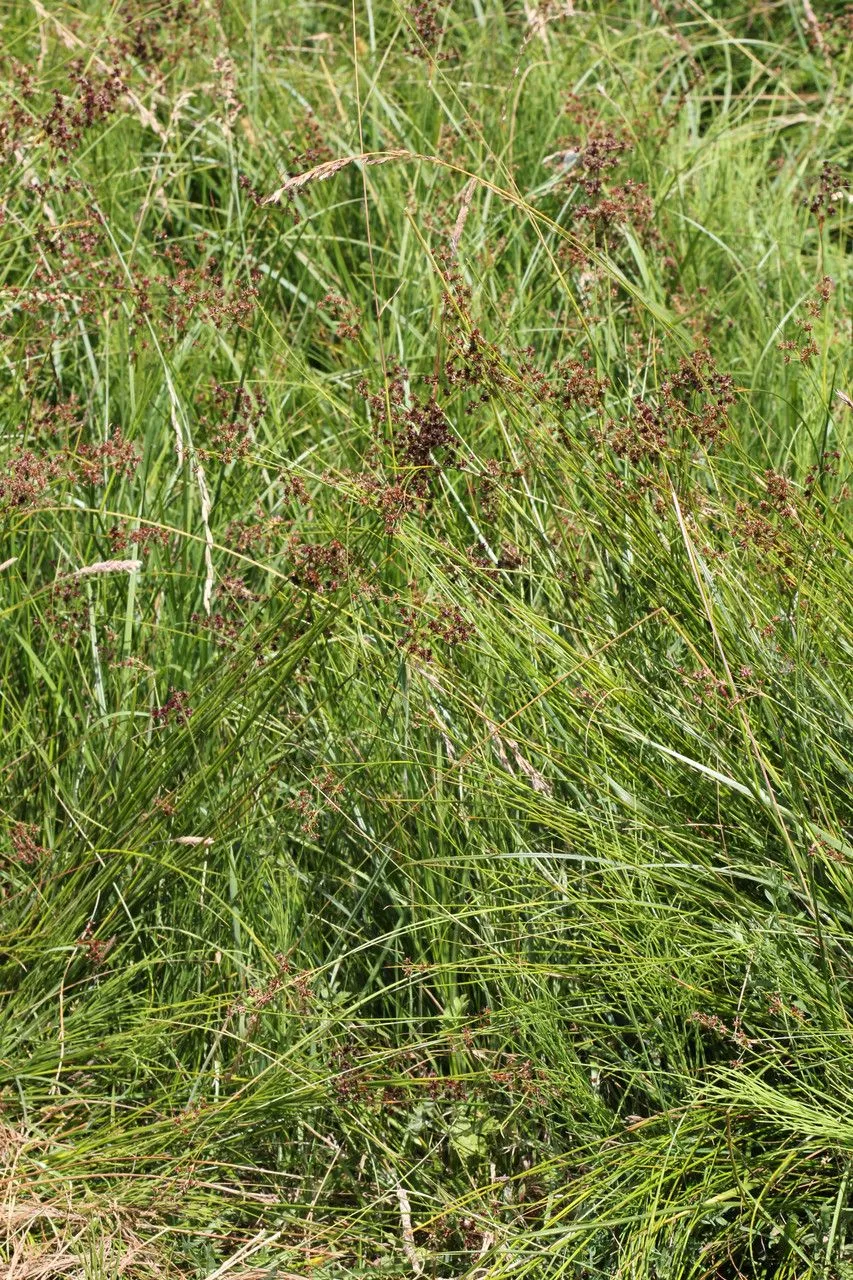
Author: Ehrh. ex Hoffm.
Bibliography: Deutschl. Fl. Bot. Taschenb. 1: 125 (1791)
Year: 1791
Status: accepted
Rank: species
Genus: Juncus
Vegetable: False
Observations: Europe, Medit. to Iraq
Sharpflower rush, known scientifically as Juncus acutiflorus, is a perennial plant belonging to the Juncaceae family. First described in “Deutschl. Fl. Bot. Taschenb. 1: 125” by the botanists Ehrhart and Hoffmann in 1791, this plant is notable for its distinctive inflorescence and adaptability to various environments.
Juncus acutiflorus can predominantly be found across Europe and parts of the Mediterranean region extending to Iraq. It thrives in moist, often marshy habitats, embracing the wet conditions that many other plant species might find challenging.
Characterized by its narrow, sharp-pointed flowers, Juncus acutiflorus typically grows in clumps with cylindrical stems that can reach heights of up to 1.2 meters. The plant’s foliage consists of grass-like leaves that emerge from the base, adding a vibrant green hue to wetlands and waterlogged meadows where it commonly resides.
This rush adapts well to a range of soil types, provided there is adequate moisture, making it a resilient species well-suited to both natural and managed wetland ecosystems. During its blooming period, the sharpflower rush exhibits a cluster of small, brownish flowers grouped tightly at the stem tips, contributing to its name. These flowers are followed by the production of tiny seeds, aiding in the plant’s propagation across its preferred habitats.
Sharpflower rush not only adds aesthetic value with its unique structure but also plays a critical role in stabilizing wetland soils, preventing erosion, and providing habitat for various wildlife species. It is a fine example of a species both robust in nature and beneficial to its ecosystem.
In summary, Juncus acutiflorus is a fascinating and ecologically significant plant prevalent across a broad geographic range. Its ability to thrive in wet, marshy landscapes makes it a resilient and important component of these delicate ecosystems.
Eng: sharpflower rush, sharp-flowered rush
Dan: spidsblomstret siv
Nor: spiss-siv
Deu: spitzblütige binse
Fra: jonc à tépales aigus, jonc à fleurs aiguës
Fin: kerrosvihvilä
Swe: kerrosvihvilä, spetståg
Nno: spiss-siv
Nob: spiss-siv
Nld: veldrus
Cym: brwynen flodeufain, brwynen flodfain, brwynen glymog â blodau blaenfain, brwynen y goedwig
En: Sharpflower rush, Sharp-flowered Rush
Ar: أسل مدبب الأزهار
Bg: Остроцветна дзука
Ca: Jonc acutiflor
Cs: Sítina ostrokvětá
Da: Spidsblomstret siv
Nl: Veldrus
Fi: Kerrosvihvilä
Fr: Jonc à tépales aigus, Jonc à fleurs aiguës, Jonc acutiflore
De: Spitzblütige Binse, Spitzblütige Simse, Spitzenblüten-Simse, Waldbinse
It: Giunco a fiori acuti
No: Spiss-siv
Nb: Spiss-siv
Nn: Spiss-siv
Pl: Sit ostrokwiatowy
Sv: Spetståg, Kerrosvihvilä
Cy: Brwynen flodeufain, Brwynen Flodfain, Brwynen Glymog â Blodau Blaenfain, Brwynen y Goedwig
Taken Jul 24, 2018 by Tela Botanica − José Luis Romero Rego (cc-by-sa)
Taken Apr 9, 2020 by sri wijayanti (cc-by-sa)
Taken Jul 19, 2022 by Robert Devoy (cc-by-sa)
Taken Aug 19, 2022 by Steve Orridge (cc-by-sa)
Taken Sep 1, 2021 by alain croibien (cc-by-sa)
Taken Jul 21, 2012 by Tela Botanica − Emmanuel STRATMAINS (cc-by-sa)
Taken Jul 18, 2021 by Dominique Vioux (cc-by-sa)
Taken Jul 4, 2015 by Tela Botanica − John DE VOS (cc-by-sa)
Taken Jul 4, 2015 by Tela Botanica − John DE VOS (cc-by-sa)
Taken Jul 4, 2015 by Tela Botanica − John DE VOS (cc-by-sa)
Taken Jul 15, 2009 by Photoflora – Benoit BOCK (©)
Taken Jul 15, 2005 by Photoflora – Benoit BOCK (©)
Taken Jul 15, 2006 by Photoflora – Benoit BOCK (©)
Taken Jan 1, 1970 by Photoflora – L’Abbé COSTE (©)
Taken Aug 15, 2007 by Photoflora – Benoit BOCK (©)
Taken Jun 13, 2016 by Tela Botanica − Dominique REMAUD (cc-by-sa)
Taken Apr 26, 2020 by Gosse Bakker (cc-by-sa)
Taken Jun 13, 2016 by Tela Botanica − Dominique REMAUD (cc-by-sa)
Taken Jun 13, 2016 by Tela Botanica − Dominique REMAUD (cc-by-sa)
Taken Apr 9, 2020 by sri wijayanti (cc-by-sa)
Taken Jul 17, 2018 by Tela Botanica − Christine Jourdan (cc-by-sa)
Taken Aug 31, 2007 by Tela Botanica − Julien BARATAUD (cc-by-sa)
Taken Jun 13, 2016 by Tela Botanica − Dominique REMAUD (cc-by-sa)
Taken Jun 13, 2016 by Tela Botanica − Dominique REMAUD (cc-by-sa)
Taken Jul 4, 2015 by Tela Botanica − John DE VOS (cc-by-sa)
Taken Sep 7, 2018 by Augustin Soulard (cc-by-sa)
Taken Jul 24, 2018 by Tela Botanica − José Luis Romero Rego (cc-by-sa)
© copyright of the Board of Trustees of the Royal Botanic Gardens, Kew.
© copyright of the Board of Trustees of the Royal Botanic Gardens, Kew.
© copyright of the Board of Trustees of the Royal Botanic Gardens, Kew.
Growth habit: Graminoid
Ph maximum: 7.0
Ph minimum: 6.5
Light: 8
Atmospheric humidity: 8
Soil nutriments: 6
Family: Myrtaceae Author: (F.Muell.) K.D.Hill & L.A.S.Johnson Bibliography: Telopea 6: 402 (1995) Year: 1995 Status:…
Family: Rubiaceae Author: Pierre ex A.Froehner Bibliography: Notizbl. Bot. Gart. Berlin-Dahlem 1: 237 (1897) Year:…
Family: Sapindaceae Author: Koidz. Bibliography: J. Coll. Sci. Imp. Univ. Tokyo 32(1): 38 (1911) Year:…
Family: Asteraceae Author: A.Gray Bibliography: Pacif. Railr. Rep.: 107 (1857) Year: 1857 Status: accepted Rank:…
Family: Fabaceae Author: Medik. Bibliography: Vorles. Churpfälz. Phys.-Ökon. Ges. 2: 398 (1787) Year: 1787 Status:…
Family: Aspleniaceae Author: (Cav.) Alston Bibliography: Bull. Misc. Inform. Kew 1932: 309 (1932) Year: 1932…